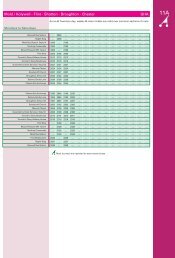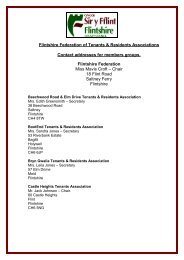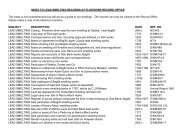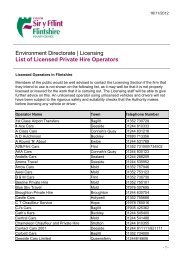The Hourglass, Spring 2012 (PDF.doc 271KB new
The Hourglass, Spring 2012 (PDF.doc 271KB new
The Hourglass, Spring 2012 (PDF.doc 271KB new
Create successful ePaper yourself
Turn your PDF publications into a flip-book with our unique Google optimized e-Paper software.
<strong>The</strong> <strong>Hourglass</strong><br />
<strong>The</strong> Newsletter of Flintshire Record Office<br />
Archives for schools<br />
Flintshire in the 19th and early 20th centuries is a longawaited<br />
education resource, developed through a<br />
partnership with the NGfL (National Grid for Learning),<br />
and is available on their website www.ngflcymru.org.uk<br />
which can also be accessed via a link from our webpages.<br />
Using contemporary photographs, prints and<br />
<strong>doc</strong>uments, we have created a series of themed<br />
presentations. Children in schools will be able to see<br />
how people lived, worked and spent their leisure time in<br />
the past.<br />
Our aim is to bring local history to life for children in<br />
Flintshire schools by enabling them to access original<br />
sources remotely. However, nothing beats handling the<br />
actual <strong>doc</strong>uments themselves, as a class from Nercwys<br />
School learned on a recent visit to the Record Office.<br />
<strong>The</strong>y enjoyed finding out how to read and handle<br />
<strong>doc</strong>uments properly, investigating the life of Daniel<br />
Owen, and the Mold Riots of 1869.<br />
Pupils from Nercwys School examining <strong>doc</strong>uments, under the<br />
watchful eye of Sue Copp, Archive Assistant<br />
Flintshire Record Office, <strong>The</strong> Old Rectory, Hawarden, CH5 3NR<br />
Tel: 01244 532364; Fax: 01244 538344; e-mail: archives@flintshire.gov.uk<br />
website: www.flintshire.gov.uk/archives<br />
<strong>Spring</strong> <strong>2012</strong><br />
Successful Volunteer Project<br />
This is the very first of over 10,000 photo’s to have been<br />
digitally scanned, in a project at Flintshire Record Office<br />
that has lasted over 7 years and has just reached<br />
completion.<br />
Broughton Wellington Bomber, 1940 (PH/9/34)<br />
<strong>The</strong> entire photographic collection of Flintshire Record<br />
Office is now saved in digital format, thanks to the<br />
tremendous efforts of a small army of volunteers –<br />
without whose fantastic work, it simply would not have<br />
been possible. All these photographs are now easily<br />
accessible on the public service computers in our<br />
searchroom, which also helps to protect and preserve<br />
the fragile originals.<br />
Staff of the Record Office have also just completed<br />
training on how to use the <strong>new</strong> “People’s Collection<br />
Wales” website, and we hope to be able to upload and<br />
display an ever-increasing number of our photos on this<br />
website in the coming months for people to enjoy.
A Hawarden Colliery<br />
Accident, 1784<br />
<strong>The</strong> following description of a near-disastrous colliery<br />
accident in one of the small coal pits near Sandycroft, on<br />
the River Dee, was written on the flyleaf of the Hawarden<br />
register of baptisms and burials 1771–1804, (ref:<br />
P/28/1/89), by Hugh Jones, the curate of the parish. <strong>The</strong><br />
blacksmith had been lowered down the shaft (120 yards<br />
deep) in a bucket suspended from a horse whim.<br />
On the 4th of January 1784 George Wainwright,<br />
blacksmith, of Pentrobin [in the parish of Hawarden] went<br />
down Sandicroft coal pit in the morning to bleed the<br />
horses there, as being the only day [‘Sunday’ inserted]<br />
on which they were not worked. Having done his<br />
business, and landing at the pit’s mouth, he put one foot<br />
out of the bucket on the treading board, by which means<br />
he lightened the bucket, which immediately kicked up on<br />
account of the ropes being shortened by the frost that<br />
then happened, and so tossed him headlong down the<br />
pit. Providentially… he had the good fortune to catch hold<br />
of the other rope at about ten yards depth, and grasped it<br />
so well that he did not slide down it above five yards more<br />
before he was able to maintain his hold, and so suspend<br />
himself by it, during which time he had the greatest<br />
presence of mind and undauntedness of heart…..he ever<br />
experienced. He then….called to the people that were<br />
above to fetch such a man of his acquaintance, in whom<br />
he had the greatest confidence to land him, and directed<br />
them how to do it. But when he was landed and found<br />
himself safe, his firmness departed, and he burst into an<br />
exceeding great flood of tears at his providential and<br />
rather miraculous escape. His mind was so agitated with<br />
the thoughts of his late danger as to make him take to his<br />
bed all that day, and [he] was sometime after unwell. <strong>The</strong><br />
only corporal hurt he received was the rubbing off of a<br />
little of the skin of one or two of his fingers by the rope.<br />
NB the pit was 120 yards deep.<br />
<strong>The</strong> account provides several interesting details, apart<br />
from those of the accident: for instance, that cold weather<br />
significantly shortened the ropes. It must have been<br />
unusual for a man to be raised and lowered in the<br />
buckets, which were normally used only for raising coal.<br />
And why was the blacksmith needed to bleed the<br />
horses? Christopher Williams<br />
Illustration of a horse whim from British Mining by Robert Hunt (1887)<br />
Diary of a<br />
Prestatyn Policeman<br />
1877-1879<br />
Thanks to notification from <strong>The</strong> National<br />
Archives of an item of interest coming up for sale,<br />
we recently purchased at auction a policeman’s<br />
diary from the 1870s [AN 4573]. Robert Griffiths,<br />
“P.C. 18”, completed this diary of his duties around<br />
Prestatyn. Each day’s entry includes a list of places<br />
visited and comments on anything of note that<br />
happened. As might be expected, he encountered<br />
plenty of “drunk & disorderly”, petty thieves and<br />
poachers, and on occasion a mad dog, a corpse<br />
on a railway line and a shooting. He was on duty<br />
at Mostyn Hall on the heir’s coming of age and at<br />
Bangor Races.<br />
<strong>The</strong> diary gives a fascinating insight into the dayto-day<br />
events of life in the area at the time.<br />
Unfortunately it was in a fragile state on its arrival<br />
here and will<br />
require the<br />
attention of<br />
our<br />
conservator<br />
before we<br />
can make it<br />
available in<br />
the searchroom.<br />
Prestatyn High Street, c.1905 (PH/50/245).<br />
Recent Accessions<br />
AN4551 – Bethania Chapel, New Brighton, Bagillt,<br />
records (not registers), 1935-1991.<br />
AN4580 – St John the Baptist V.A. Primary School,<br />
Penymynydd, Log Book, 1863-1886.<br />
AN4581 – Flintshire & Denbighshire Yeomanry,<br />
additional records, 1897-1967.<br />
AN4589 – Railway records inc. plans of Mostyn<br />
Station and train register, 1938-1967.<br />
AN4594 – File of information and photographs of the<br />
construction of <strong>The</strong> Running Hare, Ewloe.<br />
If you have any<br />
comments<br />
or suggestions for<br />
<strong>The</strong> <strong>Hourglass</strong>,<br />
please contact<br />
<strong>The</strong> Editor, tel.<br />
01244 532364<br />
or e-mail:<br />
archives@<br />
flintshire.gov.uk<br />
If you would like a<br />
copy of this<br />
publication in your<br />
own language or in<br />
an alternative<br />
format such as<br />
large print, braille or<br />
on tape, please<br />
contact the Editor.<br />
14957 2-12 design-and-print 01352 704000









